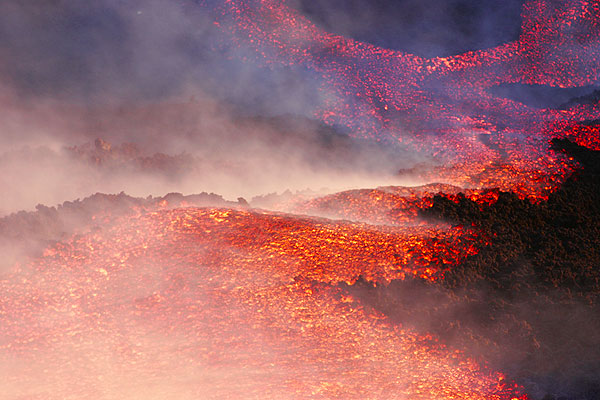Campi Flegrei (Phlegraen Fields), Pozzuoli - Napoli, Italy
5 April 2022
 Vulkane.net continues next day
Vulkane.net continues next day, 5 April 2022, with an article about swarm earthquakes occurring within the Phlegraen Fields at a location between the outskirts of the town of Pozzuoli and the crater rim of the Solfatara Volcano, Italy:
Phlegraean Fields: Another swarm quake on 05 April 2022
A new swarm quake began yesterday under the Phlegraean Fields (Campi Flegrei). Since then, the INGV has registered 30 tremors. Most of them had magnitudes in the microseismicity range, but one quake stood out, bringing it to Md 2.0. It had a hypocentre at a depth of only 1.8 km and was thus related to the volcano's hydrothermal system. Most likely, fluid movements caused rocks to fracture, or rising pressure activated a fault zone. In the first case, it would be a volcanotectonic earthquake. In the second case, it would be classified as a tectonic earthquake, even if it had been triggered indirectly by fluid movements. The epicentre of this tremor was on the southwestern crater rim of Solfatara. The next strongest quakes with magnitudes of 1.6 and 1.1 also manifested themselves in this area.
In general, Solfatara is in the centre of activity. This applies to seismicity, ground uplift and fumarolic activity. Even if people like to placate us with references to the cyclically recurring bradyseismos, saying that it is very unlikely that there will be a volcanic eruption in the foreseeable future, we have to look at the situation with a wary eye. I think it is possible that phreatic eruptions could occur at any time. Since access to the Solfatara crater has already been closed for over 5 years, I am very likely not the only one who thinks such a scenario is possible. Especially if there should be a significant temperature increase of fumarolic gases, the risk of phreatic eruptions increases significantly. But there is no mention of a temperature increase in today's weekly report.
What does the INGV's weekly report say about the Phlegraean Fields?
The gas temperature of the Pisciarelli fumarole is stable at about 95 degrees Celsius. The temperature was measured at a distance of 5 m from the gas outlet. The carbon dioxide emission did not change either. In the period between 28 March and 3 April 2022, 70 earthquakes were recorded. Among them was an earthquake with a magnitude of 3.6. This earthquake was the most energetic earthquake of the current uplift phase, which began in 2005. Volcanologists write that it was even the strongest quake since 1985! The ground uplift remains at about 13 mm per month and amounts to 87.5 cm at the RITE measuring station. January 2011 is considered the reference value.
In summary, ground uplift and seismicity are cause for concern, but the rest of the geophysical parameters are stable. Before an eruption, one would expect a rise in temperature and an increase in gas emission.
 Updated: Mar 5, 2022 08:46 GMT - 42 seconds ago
Updated: Mar 5, 2022 08:46 GMT - 42 seconds ago



